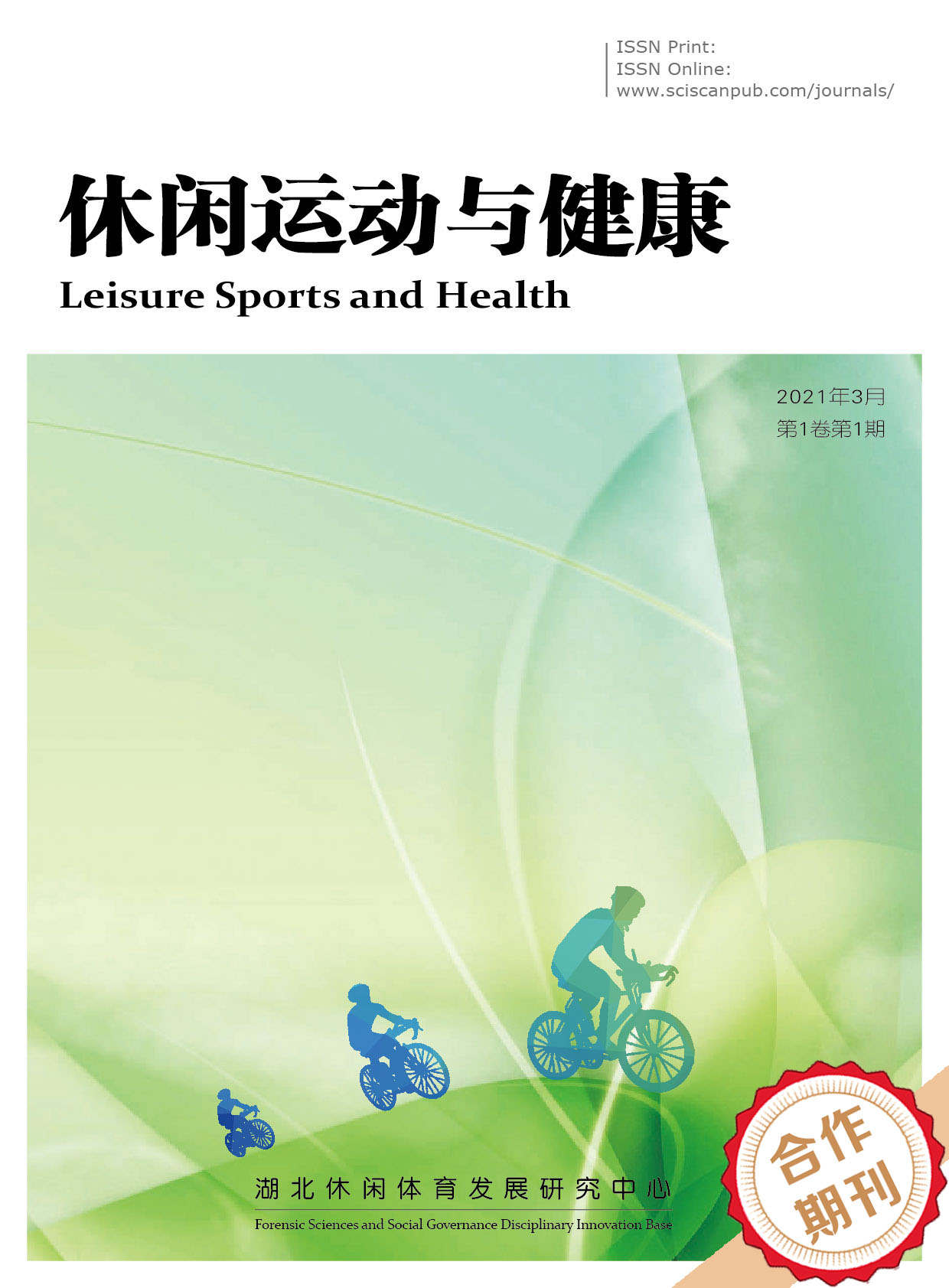Leisure Sports and Health
大城市体育消费空间利用的SWOT分析与发展战略 ——基于上海的数据审视
SWOT Analysis and Development Strategy of Sports Consumption Space Utilization in Big Cities —Data Analysis based on Shanghai
- Authors: 尹志华¹² 李璐雯³ 孙铭珠⁴ 侯士瑞⁵
-
Information:
1.华东师范大学体育与健康学院,上海 200241; 2.湖北休闲体育发展研究中心,湖北武汉 430063; 3.福建省厦门市第三中学,福建厦门 361000; 4.上海工程技术大学体育教学部,上海 201620; 5.英国爱丁堡大学莫雷教育学院,爱丁堡 EH8 9JU
-
Keywords:
Big cities; Sports consumption space; SWOT; Development strategy大城市; 体育消费空间; SWOT; 发展战略
- Abstract: “Action plan for further promoting sports consumption (2019-2020)” and “outline for building a sports power” both propose to increase the use of sports consumption space and promote the development of national fitness, which is particularly urgent in big cities with “every inch of land is money”. The research shows that: the state pays attention to sports consumption from economic investment to spatial optimization from the perspective of policy, local government starts to emphasize the benefit of urban spatial layout from the perspective of urban planning, and individuals pay more attention to the convenience and accessibility of sports fitness from the perspective of health, which are the reasons to strengthen the sports consumption space in big cities; taking Shanghai as an example, this paper investigates 500 residents and interviews 4 residents respectively, and makes SWOT analysis to optimize the sports consumption space potential, disadvantage, opportunity and threat present the situation of sports consumption space utilization in big cities; This paper puts forward the strategies to promote the utilization of sports consumption space in big cities in the future, including S-O strategy to give full play to the advantages of internal environment and grasp the opportunities of external environment; W-O strategy to make up for the disadvantages of internal environment and seize the opportunities of external environment; S-T strategy to develop the advantages of internal environment and deal with the threats of external environment; and W-T strategy to overcome the disadvantages of internal environment and avoid the threats of external environment. 《进一步促进体育消费的行动计划(2019—2020 年)》和《体育强国建设纲要》均提出要加大体育消费空间的利用,促进全民健身的开展,这在“寸土寸金”的大城市显得尤为急迫。研究表明:国家从政策角度注重体育消费从经济投入到空间优化、地方从城市规划角度开始强调城市空间布局的利民性、个体从健康角度更加强调体育健身的便利性和可及性是加强大城市体育消费空间利用的缘由;以上海为案例,对 500 名居民和 4 名居民分别进行调查和访谈,基于SWOT 分析从优势、劣势、机会和威胁呈现了大城市体育消费空间利用的情况;提出了未来推进大城市体育消费空间利用的战略:包括发挥内部环境优势,把握外部环境机遇的 S-O 战略;弥补内部环境劣势,抢抓外部环境机遇的 W-O战略;发扬内部环境优势,应对外部环境威胁的 S-T 战略和克服内部环境劣势,避免外部环境威胁的 W-T 战略。
- DOI: (DOI application in progress)
- Cite: 尹志华,李璐雯,孙铭珠,等.大城市体育消费空间利用的SWOT分析与发展战略——基于上海的数据审视[J].休闲运动与健康,2021,1(1):22-28.
党的十九大报告指出,我国社会主要矛盾已经转化为人民日益增长的美好生活需要与不平衡不充分发展之间的矛盾,这在体育领域同样如此,即目前体育领域的主要矛盾之一就是人民日益增长的健康需求与体育发展供给不足之间的矛盾。对于广大老百姓而言,随着近年来我国体育产业的快速发展,全民健身成为一股热潮,使得城市体育消费空间供应不足与居民体育需求增长之间的矛盾日渐突出,拓展体育消费新空间已经成为亟待解决的问题[1]。基于此,早在2014年,《国务院关于加快发展体育产业促进体育消费的若干意见》(国发〔2014〕46号)就提出:2025年人均体育场地面积达到2 m2的目标。但目前的实际情况而言,全国体育活动空间的情况并不乐观。据第六次全国体育场地普查数据显示,我国人均体育场地面积不足美国(16 m2)、日本(19 m2)的十分之一,这些数据反映了我国体育活动空间严重不足。为了解决体育活动空间不足的问题,国家体育总局和发展改革委于2019年1月联合印发了《进一步促进体育消费的行动计划(2019—2020年)》。该《行动计划》指出:“要充分合理利用公园绿地、城市空置场所、建筑物屋顶、地下室等‘金角银边’区域,建设便民利民的健身休闲设施,不断拓展体育消费新空间”[2]。在此基础上,国务院办公厅在2019年9月印发的《体育强国建设纲要》中又旗帜鲜明地提出要“统筹建设全民健身场地设施。加强城市绿道、健身步道、自行车道、全民健身中心、体育健身公园、社区文体广场以及足球、冰雪运动等场地设施建设,与住宅、商业、文化、娱乐等建设项目综合开发和改造相结合,合理利用城市空置场所、地下空间、公园绿地、建筑屋顶、权属单位物业附属空间”[3]。实际上,上述政策虽然是面向全国,但对于大型城市更具有典型意义。因为与中小城市相比,上海、北京、广州等大型城市面临地少人多、空间拥挤、城市发展规划对居民健身空间的需求关注不够等问题。因此,为了进一步推进大城市体育消费新空间的拓展,更好地落实国家政策精神,前提是需要了解大城市体育消费空间的利用情况,然后根据当前情况提出促进和拓展体育消费新空间的对策。
1 大城市体育消费面临的嬗变:从强调经济支撑到注重空间利用
在传统的观念中,消费等同于“花钱”,但体育消费远不止“花钱”这么简单,而是涵盖了金钱消费、时间消费、空间消费等多个方面。总体而言,我国体育消费正在面临着从强调经济支撑到注重空间利用的嬗变,这在大城市显得尤为明显,其主要体现在三个方面。
1.1 国家从政策角度注重体育消费从经济投入到空间优化
在经济不发达年代,国家的主要职责是满足普通人民的基本生存需要,即保证老百姓的衣食住行,而对于文化、体育、艺术等方面的需求则很少考虑。随着国家经济的高速发展,国家越来越富裕,人民的需求也在逐渐发生变化,因而国家的职责也发生了转变,从过去强调让人民群众“不饿肚子”到强调让人民群众“过上好日子”。基于这样的背景,国家政策也随之发生了变化。就体育领域而言,国家以往的政策更加强调竞技体育成绩,而现在更加强调在保持竞技体育水平的基础上满足人民群众的健身需求。基于此,从《国务院关于加快发展体育产业促进体育消费的若干意见》、《完善促进消费体制机制实施方案(2018—2020年)》和《进一步促进体育消费的行动计划(2019—2020年)》等文件的阐述可以看出,国家对体育消费的工作重点从加大经济投入从而让普通民众有机会参加健身,转向了强调空间优化从而让普通民众如何有足够的健身空间。国家通过在顶层设计的角度提出进一步利用好体育馆、运动场等传统健身空间,以及加强城市空置场所、公园绿地等非体育用地向体育消费新空间的转化利用[4],均是指向对体育消费空间的优化。
1.2 地方从城市规划角度开始强调城市空间布局的利民性
近年来,中国城市发展逐渐从粗放型走向精细型,尤其是对于大城市而言,在经历了疯狂扩张的规模化发展之后,开始逐渐走向内涵化发展。在粗放的疯狂扩张时代,城市发展的重点在于大量建设商场、马路、住宅等,但在推进建设的过程中缺乏高质量的规划,尤其是很少考虑在各类建筑或设施中为居民开展健身提供便利性。在这样的背景下,普通民众如果想要健身,只能前往正规的运动场或健身房进行消费,但由于正规体育场很好直接对普通民众开放,而健身房数量不多且费用不低,因此导致普通民众的健身消费空间有限。随着高质量发展时代的来临,大城市在扩张过程中逐渐开始考虑从城市整体规划的角度如何为普通民众提供充裕的空间进行健身,比如在商场中预留健身场所、在小区中建设健身设施、在公园绿地中设置健身步道或篮球场等。通过这种方式,既可以为普通民众提供更广阔的健身消费空间,又可以帮助普通民众降低健身消费的成本,这是未来的发展趋势。
1.3 个体从健康角度更加强调体育健身的便利性和可及性
随着经济的不断发展,居民的生活水平不断提高,然而居民的身体健康状况却每况愈下,呈现出城市越发达,健康越糟糕的发展局面[5]。根据《中国城市市民健康状况调查》的研究报告显示,消化道疾病、肝脏疾病、颈椎、腰椎病及骨质增生已成为困扰居民身体健康的三大疾病。这种情况在上海、北京、深圳等中国经济最发达城市显得尤为明显,城市居民健康指数较其他二线城市更低,这主要是因为大城市居民的生活节奏快、生活与工作压力大、应酬过多、饮食不规律、睡眠不充足以及缺少身体锻炼造成的[6]。近年来,党和国家不断深化体育改革、大力发展群众体育,不断引导广大居民贯彻以健身促进保健和健康的新理念,使得居民更加关注体育锻炼对身体健康的促进功能,因居民身体健康是每个人成长和实现幸福生活的重要基础。也就是说,大城市居民已经从过去关注健身的经济负担转向关注健身的便利性和可及性,因为国家富强所带来的经济增长使得健身的经济消费不再是主要考虑因素。在这样的背景下,由于大城市“寸土寸金”,正规的体育场馆和健身房容纳能力有限,因而进一步加强体育消费空间的利用已经成为普通民众最迫切的需求。
2 大城市体育消费空间利用的SWOT分析:基于上海的数据
如前所述,如何优化大城市的体育消费空间利用,可通过SWOT分析来了解当前大城市体育消费空间利用的优势、劣势、机会和威胁。所谓SWOT分析,即基于内外部竞争环境和竞争条件下的态势分析,就是将与研究对象密切相关的各种主要内部优势、劣势和外部的机会和威胁等,通过调查列举出来,然后用系统分析的思想,把各种因素相互匹配起来加以分析,从中得出一系列相应的结论,而结论通常带有一定的决策性。以上海为例,通过对上海市各区的500名居民进行调查,并对4名居民辅以访谈,从而进一步透视以上海为代表的大城市体育消费空间的利用情况。
2.1 大城市体育消费空间利用的优势(S)
大城市体育消费空间利用的优势,是指在政策支持、领导重视、城市规划、已有基础等方面体现出来的较有利的形势、环境或在某些方面超过同类的形势。根据表1的结果可知,66.4%的居民认为上海作为我国国际化程度最高的城市之一,有更多机会接触国外最前沿的体育消费空间利用信息,而这些信息的传入也会直接或间接地促进体育消费空间的利用进程和提高利用效率;59.8%的居民认为得益于上海市卓越的经济水平和开放程度,使得拓展体育消费空间有着良好的体育氛围。多数居民也认为政府对进一步促进体育消费的行动计划工作的高度重视,是开展体育消费空间利用活动的坚实后盾。超过半数居民认为上海优越的城市配置使得规划者能够高效便捷地拓展体育消费空间,如大量的建筑屋顶、地下空间和路边的健身步道等,只要合理地利用,就能有效地扩大体育消费空间。
但仅有33.0%的居民认为上海城市建筑规划合理,体育消费空间的拓展能有较高的利用率;31.6%的居民认为上海目前已被利用的体育消费空间水平较高,能够产生良好的辐射效应;26.8%的居民认为上海已有相关体育消费空间拓展设计师和规划师,能够提供高水平的指导。经过调查了解到,目前体育消费空间的设计师都是城市规划类专业的毕业生,为了进一步提高体育消费空间的利用水平及利用途径,可以考虑在体育管理专业培养体育与城市规划跨专业的学生。还有1.2%的居民提出了自己的见解,认为“家长思想观念成熟,重视孩子体育教育”也是上海市体育消费空间利用的优势之一。
表 1 上海市体育消费空间利用优势调查结果(N=500)
Table 1 Investigation on the advantage of sports consumption space utilization in Shanghai (N=500)
| 选项 | 百分比 | 排序 |
| A. 国际化程度高,有机会接触国外最新体育消费空间利用信息 | 66.4% | 1 |
| B. 上海市政府对进一步促进体育消费行动计划工作高度重视 | 52.8% | 3 |
| C. 上海市有良好的体育消费空间利用开展氛围 | 59.8% | 2 |
| D. 城市配置优越,规划者能够高效便捷地拓展体育消费空间 | 52.0% | 4 |
| E. 城市建筑规划合理,体育消费空间的拓展能有较高的利用率 | 33.0% | 5 |
| F. 上海市已被利用的体育消费空间水平较高,能产生辐射效应 | 31.6% | 6 |
| G. 上海已有体育消费空间设计师和规划师,能提供高水平指导 | 26.8% | 7 |
| H. 其他,如___________ | 1.2% | 8 |
注:本题为多选题,所以百分比总和大于100%。
此外,从访谈中得知,上海各小区都配备了基本的公共健身设施和运动场地,这为有运动需求的居民提供了基本条件,并且伴随的服务措施也给居民带来愉悦的运动体验;部分行政区的中小学主动开放学校资源,为周边居民提供操场、篮球场、羽毛球场等运动场地,且场地多功能设计得当,满足了居民对不同运动项目的需要(见表2)。上海市传统体育消费空间的利用从侧面反映出政府对全民健身较为重视,不仅是健身房、正规室内外体育场馆设施完备,学校也为居民锻炼提供一定资源。
表 2 居民对体育消费空间利用优势的访谈结果(N=4)
Table 2 Interview results of residents on the advantage of sports consumption space utilization(N=4)
| 访谈对象 | 主要观点 |
| 张XX | 在松江小区门口也有健身房,每个小区都要基本的公共健身器械及篮球场,器械有专业人员定时维修 |
| 胡XX | 安全设施完备,注重居民消费体验 |
| 吕XX | 部分学校免费对外开放提供场地资源 |
| 鹿XX | 场地利用得当,足球场和橄榄球场混合使用 |
2.2 大城市体育消费空间利用的劣势(W)
大城市体育消费空间的劣势,是指在政策落实、管理制度、居民意识等方面体现出来的不利形势或有待改善之处。根据表3的结果可知,54.0%的调查对象认为仍有部分居民缺乏体育锻炼和消费意识,这是阻碍上海体育消费空间利用的因素之一。体育锻炼和消费的意识是体育消费空间利用的需求来源和发展动力,若需求与动力不足,即便存在着各种各样的优势,体育消费空间利用在上海的发展也略显无力。46.6%的居民认为目前上海市缺乏合理有效的体育消费空间管理制度,30.4%的居民认为政府对体育消费空间利用工作落实不到位,这从侧面反映了政府层面在推进体育消费空间利用方面存在的问题。此外,有38.8%的居民认为对体育消费空间利用的经费不足是不容忽视的劣势;34.8%的居民认为体育消费空间的拓展成本相对较高,因此政府应该加强对于体育消费空间利用与拓展的经费支持力度。有30.6%的居民意识到体育消费空间拓展工作难度较大,需要很长的时间才能够得到普及。
表 3 上海市体育消费空间利用劣势调查结果(N=500)
Table 3 Investigation on the disadvantage of sports consumption space utilization in Shanghai (N=500)
| 选项 | 百分比 | 排序 |
| A. 上海市政府对体育消费空间拓展工作的落实不到位 | 30.4% | 6 |
| B. 缺乏体育消费空间管理制度 | 46.6% | 2 |
| C. 部分居民缺乏体育锻炼和消费意识 | 54.0% | 1 |
| D. 上海市体育消费空间拓展工作难度大,耗时长 | 30.6% | 5 |
| E. 对体育消费空间利用的经费支持力度不够 | 38.8% | 3 |
| F. 体育消费空间利用投资成本较高 | 34.8% | 4 |
| G. 其他,如___________ | 1.2% | 7 |
备注:本题为多选题,所以百分比总和大于100%。
此外,从表4的访谈结果可知,四位居民对体育消费空间利用劣势包括:专业场地数量少、收费高。其中有三位有着较高水平的运动需求,对专业的体育消费空间需求更高,但随之而来的是收费过高问题,往往这些居民会因为时间及金钱花费较多而选择不参与。因此,在促进体育消费空间利用工作开展时,政府及民营组织要注重利用的层次性,把握好费用和场地问题,尽量减轻民众负担,满足不同群体运动需求。
表 4 居民对体育消费空间利用优势的访谈结果(N=4)
Table 4 Interview results of residents on the disadvantage of sports consumption space utilization(N=4)
| 访谈对象 | 主要观点 |
| 张XX | 正规场馆紧缺,体育健身者无法开展自己的项目 |
| 胡XX | 专业运动场所收费较高 |
| 吕XX | 受场地空间限制,可开展的运动项目总体来说太少 |
| 鹿XX | 场地基数少,消费者时间成本非常高 |
2.3 大城市体育消费空间利用的机会(O)
大城市体育消费空间利用面临的机会,是指未来在进一步推进体育消费空间利用方面潜在的各种可利用的资源。根据表5的结果可知,64.8%的居民认为上海市体育消费空间前景广阔,有利于吸引投资商进行投资是体育消费空间利用面临的最大机会;认为居民对体育消费空间提出了更高要求(55.2%)、上海市体育国际交流频繁,可获取丰富海外体育消费空间利用经验(53.0%)、国务院《体育强国建设纲要》中对体育场地设施建设工程的重视(52.4%)、《进一步促进体育消费的行动计划(2019—2020年)》对体育消费空间利用的重视(51.2%)等也是未来进一步推进体育消费空间利用的潜在机会。但需指出的是,认为社会各界对体育消费空间利用支持度高的仅占39.6%,这说明体育消费空间利用在社会支持方面还有很大的进步空间。
表 5 上海市体育消费空间利用的机会调查结果(N=500)
Table 5 Investigation on the chance of sports consumption space utilization in Shanghai (N=500)
| 选项 | 百分比 | 排序 |
| A. 上海市体育消费空间前景广阔,有利于吸引投资商进行投资 | 64.8% | 1 |
| B. 国务院《体育强国建设纲要》中对体育场地设施建设的重视 | 52.4% | 4 |
| C.《进一步促进体育消费的行动计划(2019-2020年)》对体育消费空间利用的重视 | 51.2% | 5 |
| D. 上海市体育国际交流频繁,可获取丰富海外体育消费空间利用经验 | 53.0% | 3 |
| E. 居民对体育消费空间类型提出了更高的要求 | 55.2% | 2 |
| F. 社会各界对体育消费空间利用的支持度较高 | 39.6% | 6 |
| G. 其他,如___________ | 0.2% | 7 |
备注:本题为多选题,所以百分比总和大于100%。
此外,进一步的访谈结果表示(见表6),上海的区位优势和市民对健身空间消费的需求是未来面临的主要机会。尤其是在上海,大量拥有高学历的“新上海人”成为新生代居民的主流,他们的文化基础较高,对健康的效益认知较深,因此为进一步推动未来上海市体育消费空间的利用奠定了很好的基础。
表 6 居民对体育消费空间利用面临的机会访谈结果(N=4)
Table 6 Interview results of residents on the chance of sports consumption space utilization(N=4)
| 访谈对象 | 主要观点 |
| 张XX | 上海比较开放,对各种政策和观点能够较快吸纳 |
| 胡XX | 老百姓对健身消费空间的需求越来越大,要求也会越来越高 |
| 吕XX | 未来面临的机会有很多,但关键在于如何抓住和利用这些机会 |
| 鹿XX | 新一代市民的素养越来越高,也更加愿意利用不同类型的空间 |
2.4 大城市体育消费空间利用的威胁(T)
大城市体育消费空间利用面临的威胁,是指未来在进一步推进体育消费空间利用方面可能存在的各种困难或障碍。根据表7的结果可知,57.4%和54.6%的居民认为威胁来源于群众对体育消费空间利用的意识薄弱以及上海市的空间限制,人民体育锻炼的意识虽加强了,但是仍只选择去学校、商业健身房、体育馆等地方进行体育锻炼,本质上并未利用好体育消费空间,也无法增加人均体育活动面积的大小。另外,上海作为中国最繁华的大城市之一,房屋密集度和人口密集度均很高,可使用面积少,为体育消费空间的有效利用也造成了一定的困难。
表 7 上海市体育消费空间利用的威胁调查结果(N=500)
Table 7 Investigation on the threat of sports consumption space utilization in Shanghai (N=500)
| 选项 | 百分比 | 排序 |
| A. 政府部门对体育消费空间利用的政策支持不完善 | 44.6% | 4 |
| B. 主管业务部门对体育消费空间利用的推进不力 | 46.0% | 3 |
| C. 群众对体育消费空间利用的意识不强 | 57.4% | 1 |
| D. 大城市空间限制使得可利用的体育消费空间有限 | 54.6% | 2 |
| G. 其他,如___________ | 0.2% | 5 |
备注:本题为多选题,所以百分比总和大于100%。
针对此问题,进一步的访谈结果显示(见表8),大城市人口太多、可利用的空间少对未来促进体育消费空间利用造成了很大的威胁,形成了较为一致的意见。由此可知,未来以上海为代表的大城市在推进体育消费空间利用时,主要不是开发的新的消费空间,而是如何通过进一步拓展和优化已有的各类场馆、绿地、闲置空间等,扩大可以利用的空间,提高利用率。
表 8 居民对体育消费空间利用面临的威胁访谈结果(N=4)
Table 8 Interview results of residents on the threat of sports consumption space utilization(N=4)
| 访谈对象 | 主要观点 |
| 张XX | 上海人口太多了,人均面积不高,这是限制健身空间的主要障碍 |
| 胡XX | 城市扩张已经基本定型,未来需要进一步做好已有空间的优化 |
| 吕XX | 政府还需要进一步转变观点,如何将已有空间挖掘用于体育健身 |
| 鹿XX | 主城区和郊区发展不平衡,主城区过于拥挤而导致空间极其有限 |
总之,虽然上海作为国际大都市存在有利于体育消费空间利用的机会,但由于空间饱和对体育消费空间利用带来了威胁,居民虽然由于生活质量的提高得以对体育消费空间提出更高的要求,但对体育消费空间利用的意识仍有待增强。在对于机会与威胁并存的体育消费空间利用而言,国家应该给予群众正确的体育消费导向,政府应该着重处理空间改造问题,引导体育消费空间利用走向正确的路径。
3 推进大城市体育消费空间利用的发展战略
基于SWOT分析,促进大城市体育消费空间利用的发展战略包括:发挥内部环境优势,把握外部环境机遇的S-O战略;弥补内部环境劣势,抢抓外部环境机遇的W-O战略;发扬内部环境优势,应对外部环境威胁的S-T战略和克服内部环境劣势,避免外部环境威胁的W-T战略。
3.1 S-O战略:发挥内部环境优势,把握外部环境机遇
在未来大城市在推进体育消费空间利用的工作中,要牢牢把握现阶段国务院对体育消费空间的重视,研读出台的相关政策,利用好国务院及各省市各层级行政部门出台的政策文件来推进体育消费空间利用和拓展的有序前进,有力吸引投资商进行投资,同时发挥大城市的区位优势,吸收国际前沿的体育消费空间利用最新信息,在优越的城市配置中高效地拓展体育消费新空间;重视居民需要,创造体育消费新空间的真正价值。
3.2 W-O战略:弥补内部环境劣势,抢抓外部环境机遇
在利用体育消费空间的过程中,必须弥补目前所出现的劣势环境,大力发展已形成的机遇,要协调政府城建、体育、国土等各部门的管理分工,在短时间内向规划方向前进,高效完成体育消费空间利用工作。体育消费空间的利用是一项长久的工作,政府应保证经费支持力度,并尽可能降低体育消费空间的投资成本,以丰厚的市场前景吸引社会各界对体育消费空间利用的支持和投资。
3.3 S-T战略:开拓内部环境优势,应对外部环境威胁
在推进体育消费空间利用的历程中,要不断开拓内部环境优势以应对外部环境带来的威胁,以中央政策为指导思想,加强相关法律政策对体育消费空间利用的引导,以“互联网+体育消费空间”为新机遇,带动体育消费空间相关产业联动发展,为居民提供信息时代真正便民利民的运动参与体验。通过政府及居民自身感受的大力宣传,努力做到在各种空间中进行全民健身。
3.4 W-T战略:克服内部环境劣势,避免外部环境威胁
在大城市推进体育消费空间利用的需求下,要克服政府对该项工作落实不到位的问题,着力加强体育消费空间管理制度,区分利用前的“规划管理”以及利用后“服务管理”,避免出现“管理乱”“乱管理”的问题。结合现有的城市配置规划,充分利用城市空间中的大量“金脚银边”区域,不再让空间限制成为居民体育消费的首要威胁因素。通过各种途径大力宣扬体育消费空间利用工作,吸引广大群众参与进来,提高对体育消费空间利用意识,做到真正的“全民健身”。
参考文献
[1] 马晓卫,任波,黄海燕.互联网技术影响下体育消费发展的特征、趋势、问题与策略[J].体育学研究,2020(2):65-72.
[2] 体育总局 发展改革委.关于印发《进一步促进体育消费的行动计划(2019—2020年)》的通知[Z].2019-01-16.
[3] 国务院办公厅.关于印发体育强国建设纲要的通知[Z].2019-09-02.
[4] 陈元欣,何开放,杨金娥,等.我国利用非体育用地建设体育场地设施研究[J].体育学研究,2020(5):41-47.
[5] 唐剑.五大城市居民健康状况调查结果显示——京沪男性患“脂肪肝”人数最多[J].首都医药,2011,18(13):26-28.
[6] 方创琳.中国城市化进程亚健康的反思与警示[J].现代城市研究,2011,26(8):5-11.
















